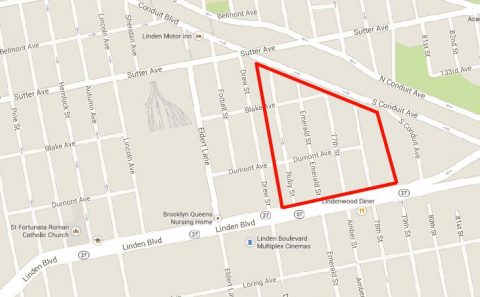Situated in a grim, nondescript corner of the wealthiest city in America, miles away from the shining skyscrapers of Park Avenue and the cocktail parties of Wall Street, there is a place known simply as “The Hole.”
Long known as body dumping ground for mobsters, the Hole lies far below grade level, lacks basic 21st century necessities like plumbing and street drainage, and is scarred by various failed and/or incomplete attempts at development and improvement. In the middle of a rapidly progressing metropolis, the Hole remains a fascinating example of a land that time seems to have forgotten — and one whose attempts to modernize have been fraught with corruption, neglect, and general dysfunction.
Roughly bordered on the north by South Conduit Avenue, to the west by Eldert Lane, to the east by 78th Street, and to the south by the bustling thoroughfare of Linden Boulevard, the Hole is a 12-square block area straddling Brooklyn to the west and Queens to the east. While some locals refer to the Hole as part of Lindenwood, Queens, others argue that the area is actually part of either East New York, Brooklyn or Howard Beach, Queens.
The Hole isn’t part of one specific neighborhood or even one borough, a challenge that makes it hard to determine who is responsible for its development or upkeep. Because it’s not technically a New York City neighborhood, precise demographic information about the Hole is hard to find. But two visits to the Hole, along with a recent documentary about the area by filmmakers Courtney Fathom Sell and Billy Feldman, show that it is home to a small population of African-American, Italian, and Latino residents.
The area is extremely remote and relatively inaccessible by public transit. To get to the Hole by subway, one must take the A train to Grant Avenue (17 stops away from Manhattan), and then endure an unpleasant mile long walk across Conduit Boulevard with its six dangerous lanes of commuters speeding to and from John F. Kennedy airport. The best option for traveling to the Hole is taking the B15 and BM5 buses to Linden Boulevard / 79th Street — both of which are somewhat unreliable, and still miles away from Downtown Brooklyn and Long Island City, let alone Manhattan.
The Hole is less an official neighborhood name than a colloquial title, derived from the fact that the neighborhood lies 30 feet below grade level, giving it the appearance of a sunken marshland when viewed from nearby streets. The Hole’s low-lying topography and lack of a proper drainage system means it is not uncommon for flooding to occur on local streets, particularly Ruby Street on the Westernmost side.
The homes in the Hole lack sewage systems, instead relying on antiquated septic tanks and cesspools. Because the Hole’s residences — most of which are situated on former small farms — have such old cesspool systems, the pipes frequently burst, resulting in raw sewage seeping out into vacant lots and sinking into the ground.
In the early 2000s, the Department of Environmental Protection planned to finally incorporate the Hole into the city’s sewer system, and in turn create possibilities for much needed development in the area. This process proved to be nearly impossible, as it required raising the land 30 feet up to grade level. When the city began backfilling the Drew Street section of the Hole (which is technically on the Brooklyn side), the homes along the street saw their first floors become basements, and their second floors become first floors.
The Department of Environmental Protection has stated that the Hole would need to be raised entirely to install proper, up-to-date sewage technology — a project that would require the city to either purchase the homes of the Hole’s residents, or wait for them to move out.
Few private developers have invested in the area. In 2008, a controversy ensued over a proposed development called the Cobblestone Estates. Planned at a location east of 78th Street, north of Linden Boulevard and south of South Conduit Avenue, Cobblestone Estates would have been a gated residential community at the very eastern edge of the Hole.
The Cobblestone Estates project was abandoned after hidden-camera videotapes surfaced suggesting Assemblywoman Diane M. Gordon of Brooklyn offered to help Ranjan Batheja, the developer and contractor of the Cobblestone Estates, secure a $2 million plot of vacant city land in her district in East New York. In return, Gordon asked that he give her a $1 house in the exclusive development — one with granite and cherry-wood fixtures, walk-in closets, and an 8 x 14-foot bathroom.
Batheja, desperate to appease prosecutors after previously attempting to bribe an undercover agent, had secretly filmed the conversations with Gordon, who was eventually convicted on eight of nine counts including receiving bribes, official misconduct, and receiving awards for official misconduct. She was sentenced in 2008 to 2-6 years in jail.
After the corruption trial and Gordon’s conviction, the proposed development site sat vacant for seven years. Consistent with the forlorn surroundings of the Hole, the site lay behind a chain-link fence with a green-painted particle board and black tarp lashed to it. Liz Watt, president of the local Jewel Streets Civic Association and a resident of 78th Street in the Hole, said she lived in constant fear of the site’s 20 foot high excavated rock and fill crashing down on her house. As she told the New York Times, “We were hoping if they build maybe we could tap into the sewer here and we could get some type of relief, but I don’t think it’s going to happen in my lifetime.”
Eventually, in 2015, construction on a new three-building, 250,000 square-foot shopping mall called Linden Center began on the former Cobblestone Estates site by Bawabeh Realty Holdings. The mall faces away from the sunken adjacent land, and caters more to Manhattan-bound commuters on Linden Boulevard than residents of the Hole, which still has no proper businesses to speak of in its low-lying, desolate streets.
Recently, the New York City Department of Transportation announced various capital improvements on East New York streets, including bike lanes and other traffic calming measures on Loring Street, a Hole-adjacent area just across Linden Boulevard that also lies several feet below grade level.
Capital improvement projects are occurring on nearby streets, and various blocks have been raised to grade level in piecemeal fashion. But complete modernization of the Hole would destroy most of the area’s homes, and displace neighborhood fixtures like the Federation of Black Cowboys. The fate of the Hole and its residents remain uncertain.
Works Cited
-“A – 8th Avenue Express.” MTA/New York City Transit Subway Line Information. N.p., n.d. Web. 01 May 2017.
-“Echoes of the Wild West Mark an Urban Frontier.” The New York Times. The New York Times, 17 Oct. 2004. Web. 02 May 2017.
–THE HOLE. Vimeo, 2010. Web. 02 May 2017.
–Nazaryan, Alexander. “The ‘Hole’ is 12 Feet Below Street Level and About A Century Behind the Rest of New York.” Newsweek. N.p., 08 Apr. 2016. Web. 01 May 2017.
–Louis, Kathleen. “Forgotten Queens Community Has Become Dumping Ground.” Queens Chronicle. N.p., 21 Feb. 2002. Web. 03 May 2017.
-“Loring Avenue and Amber Street, Queens NY.” Google Maps. Google, n.d. Web. 03 May 2017. <https://www.google.com/maps/@40.668579,-73.8578049,3a,75y,183.2h,72.78t/data=!3m6!1e1!3m4!1s2aFBAVVyjk49-RHna5tqtw!2e0!7i13312!8i6656?shorturl=1>.
–Curbed. “Tour ‘The Hole,’ NYC’s Rundown Brooklyn-Queens Border Town.” Curbed NY. Curbed NY, 24 June 2014. Web. 02 May 2017.
– “Feds Search ‘Mafia Graveyard’ in New York.” Fox News. FOX News Network, 5 Oct. 2004. Web. 04 May 2017.
–Newman, Andy. “Eight Undeveloped Acres and Secret Videotapes Figure in Official’s Trial.” The New York Times. The New York Times, 28 Mar. 2008. Web. 4 May 2017.
–Shifrel, Scott. “Former B’klyn assemblywoman jailed for bribery conviction.” NY Daily News. N.p., 22 Jan. 2009. Web. 01 May 2017.
–Matua, Angela. “New shopping center on the way to Lindenwood.” QNS.com. QNS.com, 20 July 2015. Web. 02 May 2017.
–P., Sunday, R. L., Lina A., and Jatara I. “Linden Center – Lindenwood – Howard Beach, NY.” Yelp. N.p., 18 Feb. 2017. Web. 05 May 2017.
–Kilgannon, Corey. “Black Cowboys Ride the Range in Queens, and Keep a Sharp Lookout for Traffic.” The New York Times. The New York Times, 09 Oct. 2006. Web. 02 May 2017.
–“NEW YORK CITY FEDERATION OF BLACK COWBOYS – Home Page.” Nycfederationofblackcowboys. N.p., 2011-2017. Web. 07 May 2017.
-Ronner, Abby. “Giddy Out: Will New York’s Federation of Black Cowboys Be Sent Packing?” Village Voice. N.p., 20 Apr. 2016. Web. 04 May 2017.
–Gannon, Michael. “Dead horse stable closed in Howard Beach.” Queens Chronicle. N.p., 28 Mar. 2013. Web. 07 May 2017.
– Joiner, Bryan. “Black Cowboys Want To Expand For New Educational Program.” Queens Chronicle. N.p., 4 Mar. 2004. Web. 07 May 2017.
–Nir, Sarah Maslin. “Decrepit Stable in Queens Is Shut Down After 6 Horses Die.” The New York Times. The New York Times, 20 Mar. 2013. Web. 08 May 2017.
–Colangelo, Lisa L. “City closes Queens stables temporarily after six horse deaths.” NY Daily News. N.p., 19 Mar. 2013. Web. 06 May 2017.
-United States. New York City Department of Transportation. LORING AVE SAFETY IMPROVEMENTS. New York: n.p., 2016. Print.
– Marty, Jonathan. Screenshot of BK/QNS Border. 2017. New York City.
-Marty, Jonathan. Chickens at the Hole. 2016. New York City.
– Marty, Jonathan. Flooded Ruby Street. 2016. New York City.
– Marty, Jonathan. Abandoned Home in the Hole. 2016. New York City.
– Marty, Jonathan. Cedar Lane Stables Sign. 2016. New York City.
– Marty, Jonathan. Amber Street Retaining Wall Screenshot. 2017. New York City.

